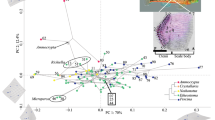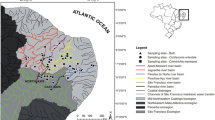Abstract
Body shape is a morphological attribute that frequently changes as organisms adapt to environmental fluctuations and optimize the use of available resources. In fish whose distribution includes estuarine and riverine environments, it is common to observe changes in body shape that are related to maneuverability and speed of movement in response to temporal and spatial variation in water flow. Here, through geometric morphometric and linear morphometric analysis, the intraspecific morphological variation of the cichlids Amphilophus trimaculatus, Astatheros macracanthus, and Mayaheros beani was evaluated to determine if there are repeated patterns of variation in body shape associated with estuarine and riverine environments. The three species showed the same trend of morphological variation; in the estuaries, the specimens were generally deeper and robust, with a long head and short caudal peduncle, while river specimens had shallowed and fusiform bodies with a short head and long caudal peduncle. The magnitude of the changes was not the same in the three species, as M. beani showed greater differentiation, and some morphological measures showed changes in opposite directions between the species. These findings indicate that the environment occupied by the species is an important factor in the differentiation of body shape, probably due to water flow, although other factors may determine the magnitude and direction of change in some morphological traits.




Similar content being viewed by others
Data availability
All the data used in this study are presented in its text and figures.
References
Adams DC (2014) A generalized K statistic for estimating phylogenetic signal from shape and other high-dimensional multivariate data. Syst Biol 63(5):685–697. https://doi.org/10.1093/sysbio/syu030
Aguilar-Contreras Y, González-Díaz AA, Mejía O, Rodiles-Hernández R (2021) Morphometric variation of Middle-American cichlids: Theraps– Paraneetroplus clade (Actinopterygii: Cichliformes: Cichlidae). Acta Ichthyol Piscat 51(4):403–412. https://doi.org/10.3897/aiep.51.69363
Burress ED, Piálek L, Casciotta J, Almirón A, Říčan O (2023) Rapid parallel morphological and mechanical diversification of south American pike cichlids (Crenicichla). Syst Biol 72(1):120–133. https://doi.org/10.1093/sysbio/syac018
Costa C, Cataudella S (2007) Relationship between shape and trophic ecology of selected species of sparids of the Caprolace coastal lagoon (Central Tyrrhenian sea). Environ Biol Fish 78:115–123. https://doi.org/10.1007/s10641-006-9081-9
Crampton WGR (2011) An ecological perspective on diversity and distributions. In: Albert JS, Reis RE (eds) Historical biogeography of neotropical freshwater fishes. University of California Press, Berkeley, USA, pp 165–189
Eklöv P, Svanbäck R (2006) Predation risk influences adaptive morphological variation in fish populations. Am Nat 167(3):440–452. https://doi.org/10.1086/499544
Franssen NR, Harris J, Clark SR, Schaefer JF, Stewart LK (2013) Shared and unique morphological responses of stream fishes to anthropogenic habitat alteration. Proc R Soc B 280:20122715. https://doi.org/10.1098/rspb.2012.2715
González-Díaz AA, Quiñones M, Rodiles-Hernández R, Velásquez-Martínez J (2008) Fishes of La Venta River in Chiapas, Mexico. Zootaxa 1685(1):47–54. https://doi.org/10.11646/zootaxa.1685.1.3
Gotanda KM, Reardon EE, Murphy SMC, Chapman LJ (2012) Critical swim speed and fast-start response in the African cichlid Pseudocrenilabrus multicolor victoriae: convergent performance in divergent oxygen regimes. Can J Zool 90(5):545–554. https://doi.org/10.1139/z2012-019
Hammer Ø, Harper DAT, Ryan PD (2001) PAST: paleontological statistics software package for education data analysis. Paleontologia Electronica 4(1):e4
Hernández J, Villalobos-Leiva A, Bermúdez A, Ahumada-C D, Suazo MJ, Correa M, Díaz A, Benítez HA (2022) Ecomorphology and morphological disparity of Caquetaia kraussii (Perciformes: Cichlidae) in Colombia. Animals 12(23):3438. https://doi.org/10.3390/ani12233438
Hopper GW, Morehouse RL, Tobler M (2017) Body shape variation in two species of darters (Etheostoma, Percidae) and its relation to the environment. Ecol Freshw Fish 26:4–18. https://doi.org/10.1111/eff.12245
Johnson JB, Belk MC (2001) Predation environment predicts divergent life-history phenotypes among populations of the livebearing fish Brachyrhaphis rhabdophora. Oecologia 126:142–149. https://doi.org/10.1007/s004420000504
Kelley JL, Davies PM, Collin SP, Grierson PF (2017) Morphological plasticity in a native freshwater fish from semiarid Australia in response to variable water flows. Ecol Evol 7:6595–6605. https://doi.org/10.1002/ece3.3167
Klingenberg CP (2011) MorphoJ: an integrated software package for geometric morphometrics. Mol Ecol Resour 11:353–357. https://doi.org/10.1111/j.1755-0998.2010.02924.x
Langerhans RB (2008) Predictability of phenotypic differentiation across flow regimes in fishes. Integr Comp Biol 48(6):750–768. https://doi.org/10.1093/icb/icn092
Langerhans RB, DeWitt TJ (2004) Shared and unique features of evolutionary diversification. Am Nat 164(3):335–349. https://doi.org/10.1086/422857
Langerhans RB, Reznick D (2009) Ecology and evolution of swimming performance in fishes: predicting evolution with biomechanics. In: Domenici P, Kapoor BG (eds) Fish locomotion: an etho-ecological perspective. CRC, USA, pp 200–248
Larouche O, Gartner S, Westneat M, Evans K (2022) Mosaic evolution of the skull in labrid fishes involves differences in both tempo and mode of morphological change. Syst Biol 72(2):419–432. https://doi.org/10.1093/sysbio/syac061
López-Fernández H (2021) Neotropical riverine cichlids: adaptive radiation and macroevolution at continental scales. In: Abate MA, Noakes DLG (eds) The behavior, ecology, and evolution of cichlid fishes. Springer Dordrecht, Corvallis, USA, pp 135–173. https://doi.org/10.1007/978-94-024-2080-7_5
McMahan CD, Kutz J, Murray C, Chakrabarty P, Geheber AD, Elías D (2017) Objectively measuring subjectively described traits: geographic variation in body shape and caudal coloration pattern within Vieja Melanurus (Teleostei: Cichlidae). Rev Biol Trop 65(2):623–631. https://doi.org/10.15517/rbt.v65i2.25500
Miller RR, Minckley WL, Norris S (2005) Freshwater fishes of Mexico. University Chicago, Chicago
Oke KB, Rolshausen G, LeBlond C, Hendry AP (2017) How parallel is parallel evolution? A comparative analysis in fishes. Am Nat 190(1):1–16. https://doi.org/10.1086/691989
Olsson J, Svanbäck R, Eklöv P (2007) Effects of resource level and habitat type on behavioral and morphological plasticity in eurasian perch. Oecologia 152:48–56. https://doi.org/10.1007/s00442-006-0588-8
Perazzo GX, Corrêa F, Salzburger W, Gava A (2019) Morphological differences between an artificial lentic and adjacent lotic environments in a characid species. Rev Fish Biol Fisher 29:935–949. https://doi.org/10.1007/s11160-019-09582-y
Recknagel H, Elmer KR, Meyer A (2014) Crater Lake habitat predicts morphological diversity in adaptative radiations of cichlid fishes. Evolution 68:2145–2155. https://doi.org/10.1111/evo.12412
Říčan O, Pangrácová A, Rodriguez Haro CE, Říčanová Š (2023) Repeated ecomorphological divergence in Bujurquina (Teleostei: Cichlidae) body shape. J Vertebr Biol 72(23004):1–20. https://doi.org/10.25225/jvb.23004Rohlf FJ (2017) TpsDig, Thin Plate Spline Digitise, version 2.31. Department of Ecology and Evolution, University of New York Stony Brook
Říčan O, Piálek L, Dragová K, Novák J (2016) Diversity and evolution of the middle American cichlid fishes (Teleostei: Cichlidae) with revised classification. Vertebr Zool 66:1–102. https://doi.org/10.3897/vz.66.e31534
Rohlf FJ (2018) TpsUtil, thin plate spline utility, version 1.81. Department of Ecology and Evolution, University of New York Stony Brook
Ruehl CB, Shervette V, Dewitt TJ (2011) Replicated shape variation between simple and complex habitats in two estuarine fishes. Biol J Linn Soc 103(1):147–158. https://doi.org/10.1111/j.1095-8312.2011.01626.x
Sánchez-González JR, Nicieza AG (2017) Phenotypic convergence of artificially reared and wild trout is mediated by shape plasticity. Ecol Evol 7(15):5922–5929. https://doi.org/10.1002/ece3.3156
Schofield PJ, Loftus WF, Fontaine JA (2009) Salinity effects on behavioural response to hypoxia in the non-native mayan cichlid Cichlasoma urophthalmus from Florida Everglades wetlands. J Fish Biol 74:1245–1258. https://doi.org/10.1111/j.1095-8649.2009.02192.x
Scott S, Rojas P, Vila I (2020) Meristic and morphological differentiation of Orestias species (Teleostei; Cyprinodontiformes) from the southern Altiplano. Environ Biol Fish 103:939–951. https://doi.org/10.1007/s10641-020-00995-4
Seilacher A (1991) Self-organizing mechanisms in morphogenesis and evolution. In: Schmidt-Kittler N, Vogel K (eds) Constructional morphology and evolution. Springer, Berlin, Heidelberg, pp 251–271. https://doi.org/10.1007/978-3-642-76156-0_17
Sheets HD (2014) Integrated Morphometrics Package 8: 2014. [IMP]
Steele S, López-Fernández H (2014) Body size diversity and frequency distributions of neotropical cichlid fishes (cichliformes: Cichlidae: Cichlinae). PLoS ONE 9e106336. https://doi.org/10.1371/journal.pone.0106336
Svanbäck R, Eklöv P (2002) Effects of habitat and food resources on morphology and ontogenetic growth trajectories in perch. Oecologia 131(1):61–70. https://doi.org/10.1007/s00442-001-0861-9
Tobler M, Hastings L (2011) Convergent patterns of body shape differentiation in four different clades of poeciliid fishes inhabiting sulfide springs. Evol Biol 38(4):412–421. https://doi.org/10.1007/s11692-011-9129-4
Winemiller KO (1991) Ecomorphological diversification in lowland freshwater fish assemblages from five biotic regions. Ecol Monogr 61:343–365. https://doi.org/10.2307/2937046
Winemiller KO, Kelso-Winemiller LC, Brenkert AL (1995) Ecomorphological diversification and convergence in fluvial cichlid fishes. Environ Biol Fish 44:235–261. https://doi.org/10.1007/BF00005919
Zelditch ML, Swiderski D, Sheets D, Fink W (2004) Geometric morphometrics for biologist: a primer. Elsevier Academy
Acknowledgements
AAGD and MSB thank SNI-CONAHCYT, and MSB thanks CONACHYT for the postdoctoral grant and SNI-CONACHYT. We thank anonymous reviewers for their helpful comments on the manuscript.
Author information
Authors and Affiliations
Contributions
All authors contributed to the study conception and design. Material preparation, data collection, and analysis were performed by Alfonso A. González-Díaz and Miriam Soria-Barreto. The first draft of the manuscript was written by Alfonso A. González-Díaz and all authors commented on previous versions of the manuscript. All authors read and approved the final manuscript.
Corresponding author
Ethics declarations
Ethical approval
Care was taken in the handling and use of the captured fish in accordance with SEMARNAT’s laws, guidelines, and policies. Sampling was authorized under the fishing permit number PPF/DGOPA249/14 from CONAPESCA.
Conflict of interest
The authors declare no competing interests.
Additional information
Publisher’s note
Springer Nature remains neutral with regard to jurisdictional claims in published maps and institutional affiliations.
Electronic supplementary material
Below is the link to the electronic supplementary material.
Rights and permissions
Springer Nature or its licensor (e.g. a society or other partner) holds exclusive rights to this article under a publishing agreement with the author(s) or other rightsholder(s); author self-archiving of the accepted manuscript version of this article is solely governed by the terms of such publishing agreement and applicable law.
About this article
Cite this article
González-Díaz, A.A., Soria-Barreto, M. & Martínez-Cárdenas, L. Repeated patterns in the body shape of distantly related estuarine and riverine cichlids from Northern Middle America. Environ Biol Fish 107, 335–345 (2024). https://doi.org/10.1007/s10641-024-01534-1
Received:
Accepted:
Published:
Issue Date:
DOI: https://doi.org/10.1007/s10641-024-01534-1




